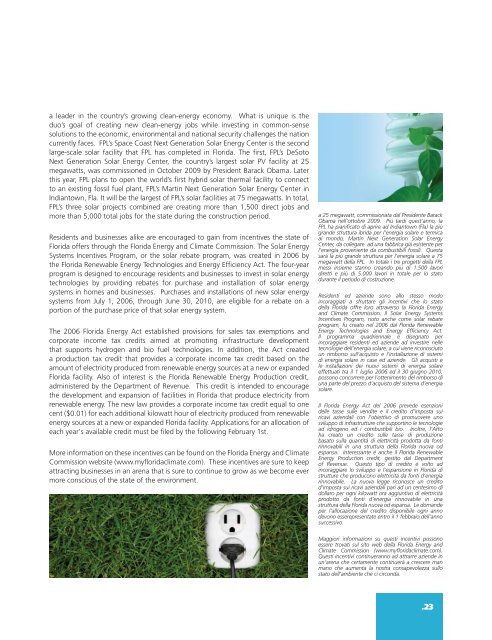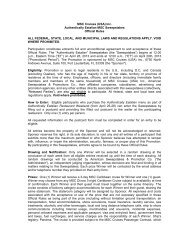interview - Italy-America Chamber of Commerce, Southeast
interview - Italy-America Chamber of Commerce, Southeast
interview - Italy-America Chamber of Commerce, Southeast
You also want an ePaper? Increase the reach of your titles
YUMPU automatically turns print PDFs into web optimized ePapers that Google loves.
a leader in the country’s growing clean-energy economy. What is unique is the<br />
duo’s goal <strong>of</strong> creating new clean-energy jobs while investing in common-sense<br />
solutions to the economic, environmental and national security challenges the nation<br />
currently faces. FPL’s Space Coast Next Generation Solar Energy Center is the second<br />
large-scale solar facility that FPL has completed in Florida. The first, FPL’s DeSoto<br />
Next Generation Solar Energy Center, the country’s largest solar PV facility at 25<br />
megawatts, was commissioned in October 2009 by President Barack Obama. Later<br />
this year, FPL plans to open the world’s first hybrid solar thermal facility to connect<br />
to an existing fossil fuel plant, FPL’s Martin Next Generation Solar Energy Center in<br />
Indiantown, Fla. It will be the largest <strong>of</strong> FPL’s solar facilities at 75 megawatts. In total,<br />
FPL’s three solar projects combined are creating more than 1,500 direct jobs and<br />
more than 5,000 total jobs for the state during the construction period.<br />
Residents and businesses alike are encouraged to gain from incentives the state <strong>of</strong><br />
Florida <strong>of</strong>fers through the Florida Energy and Climate Commission. The Solar Energy<br />
Systems Incentives Program, or the solar rebate program, was created in 2006 by<br />
the Florida Renewable Energy Technologies and Energy Efficiency Act. The four-year<br />
program is designed to encourage residents and businesses to invest in solar energy<br />
technologies by providing rebates for purchase and installation <strong>of</strong> solar energy<br />
systems in homes and businesses. Purchases and installations <strong>of</strong> new solar energy<br />
systems from July 1, 2006, through June 30, 2010, are eligible for a rebate on a<br />
portion <strong>of</strong> the purchase price <strong>of</strong> that solar energy system.<br />
The 2006 Florida Energy Act established provisions for sales tax exemptions and<br />
corporate income tax credits aimed at promoting infrastructure development<br />
that supports hydrogen and bio fuel technologies. In addition, the Act created<br />
a production tax credit that provides a corporate income tax credit based on the<br />
amount <strong>of</strong> electricity produced from renewable energy sources at a new or expanded<br />
Florida facility. Also <strong>of</strong> interest is the Florida Renewable Energy Production credit,<br />
administered by the Department <strong>of</strong> Revenue. This credit is intended to encourage<br />
the development and expansion <strong>of</strong> facilities in Florida that produce electricity from<br />
renewable energy. The new law provides a corporate income tax credit equal to one<br />
cent ($0.01) for each additional kilowatt hour <strong>of</strong> electricity produced from renewable<br />
energy sources at a new or expanded Florida facility. Applications for an allocation <strong>of</strong><br />
each year's available credit must be filed by the following February 1st.<br />
More information on these incentives can be found on the Florida Energy and Climate<br />
Commission website (www.myfloridaclimate.com). These incentives are sure to keep<br />
attracting businesses in an arena that is sure to continue to grow as we become ever<br />
more conscious <strong>of</strong> the state <strong>of</strong> the environment.<br />
a 25 megawatt, commissionata dal Presidente Barack<br />
Obama nell’ottobre 2009. Piú tardi quest’anno, la<br />
FPL ha pianificato di aprire ad Indiantown (Fla) la piú<br />
grande struttura ibrida per l’energia solare e termica<br />
al mondo, Martin Next Generation Solar Energy<br />
Center, da collegare ad una fabbrica giá esistente per<br />
l’energia proveniente da combustibili fossili. Questa<br />
sará la piú grande struttura per l’energia solare a 75<br />
megawatt della FPL. In totale i tre progetti della FPL<br />
messi insieme stanno creando piú di 1.500 lavori<br />
diretti e piú di 5.000 lavori in totale per lo stato<br />
durante il periodo di costruzione.<br />
Residenti ed aziende sono allo stesso modo<br />
incoraggiati a sfruttare gli incentivi che lo stato<br />
della Florida <strong>of</strong>fre loro attraverso la Florida Energy<br />
and Climate Commission. Il Solar Energy Systems<br />
Incentives Program, noto anche come solar rebate<br />
program, fu creato nel 2006 dal Florida Renewable<br />
Energy Technologies and Energy Efficiency Act.<br />
Il programma quadriennale é disegnato per<br />
incoraggiare residenti ed aziende ad investire nelle<br />
tecnologie dell’energia solare, a cui viene riconosciuto<br />
un rimborso sull’acquisto e l’installazione di sistemi<br />
di energia solare in case ed aziende. Gli acquisti e<br />
le installazioni dei nuovi sistemi di energia solare<br />
effettuati tra il 1 luglio 2006 ed il 30 giugno 2010,<br />
possono concorrere per l’ottenimento del rimborso di<br />
una parte del prezzo d’acquisto del sistema d’energia<br />
solare.<br />
Il Florida Energy Act del 2006 prevede esenzioni<br />
delle tasse sulle vendite e il credito d’imposta sui<br />
ricavi aziendali con l’obiettivo di promuovere uno<br />
sviluppo di infrastrutture che supportino le tecnologie<br />
ad idrogeno ed i combustibili bio. Inoltre, l’Atto<br />
ha creato un credito sulle tasse di produzione<br />
basato sulla quantitá di elettricitá prodotta da fonti<br />
rinnovabili in una struttura della Florida nuova od<br />
espansa. Interessante é anche il Florida Renewable<br />
Energy Production credit, gestito dal Department<br />
<strong>of</strong> Revenue. Questo tipo di credito é volto ad<br />
incoraggiare lo sviluppo e l’espansione in Florida di<br />
strutture che producono elettricitá da fonti d’energia<br />
rinnovabile. La nuova legge riconosce un credito<br />
d’imposta sui ricavi aziendali pari ad un centesimo di<br />
dollaro per ogni kilowatt ora aggiuntivo di elettricitá<br />
prodotto da fonti d’energia rinnovabile in una<br />
struttura della Florida nuova od espansa. Le domande<br />
per l’allocazione del credito disponibile ogni anno<br />
devono esserepresentate entro il 1 febbraio dell’anno<br />
successivo.<br />
Maggiori informazioni su questi incentivi possono<br />
essere trovati sul sito web della Florida Energy and<br />
Climate Commission (www.myfloridaclimate.com).<br />
Questi incentivi continueranno ad attrarre aziende in<br />
un’arena che certamente continuerá a crescere man<br />
mano che aumenta la nostra consapevolezza sullo<br />
stato dell’ambiente che ci circonda.<br />
.23















